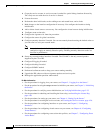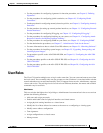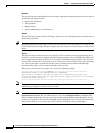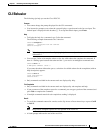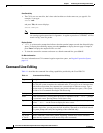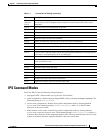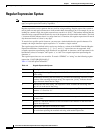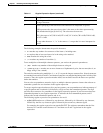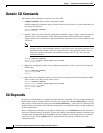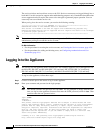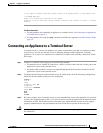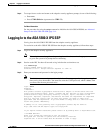
1-10
Cisco Intrusion Prevention System CLI Sensor Configuration Guide for IPS 7.1
OL-19892-01
Chapter 1 Introducing the CLI Configuration Guide
Generic CLI Commands
Generic CLI Commands
The following CLI commands are generic to the Cisco IPS.
• configure terminal—Enters global configuration mode.
Global configuration commands apply to features that affect the system as a whole rather than just
one protocol or interface.
sensor# configure terminal
sensor(config)#
• service—Takes you to the following configuration submodes: analysis-engine, anomaly-detection,
authentication, event-action-rules, external-product-interfaces, health-monitor, host, interface,
logger, network-access, notification, signature-definition, ssh-known-hosts, trusted-certificates, and
web-server.
Note The anomaly-detection, event-action-rules, and signature-definition submodes are multiple
instance services. One predefined instance is allowed for each. For anomaly-detection, the
predefined instance name is ad0. For event-action-rules, the predefined instance name is
rules0. For signature-definition, the predefined instance name is sig0. You can create
additional instances.
sensor# configure terminal
sensor(config)# service event-action-rules rules0
sensor(config-rul)#
• end—Exits configuration mode or any configuration submodes. It takes you back to the top-level
EXEC menu.
sensor# configure terminal
sensor(config)# end
sensor#
• exit—Exits any configuration mode or closes an active terminal session and terminates the EXEC
mode. It takes you to the previous menu session.
sensor# configure terminal
sensor(config)# service event-action-rules rules0
sensor(config-rul)# exit
sensor(config)# exit
sensor#
CLI Keywords
In general, use the no form of a command to disable a feature or function. Use the command without the
keyword no to enable a disabled feature or function. For example, the command ssh host-key ip_address
adds an entry to the known hosts table, the command no ssh host-key ip_address removes the entry from
the known hosts table. Refer to the individual commands for a complete description of what the no form
of that command does.
Service configuration commands can also have a default form. Use the default form of the command to
return the command setting to its default. This keyword applies to the service submenu commands used
for application configuration. Entering
default with the command resets the parameter to the default
value. You can only use the default keyword with commands that specify a default value in the
configuration files.



